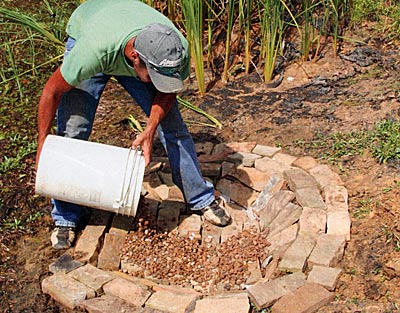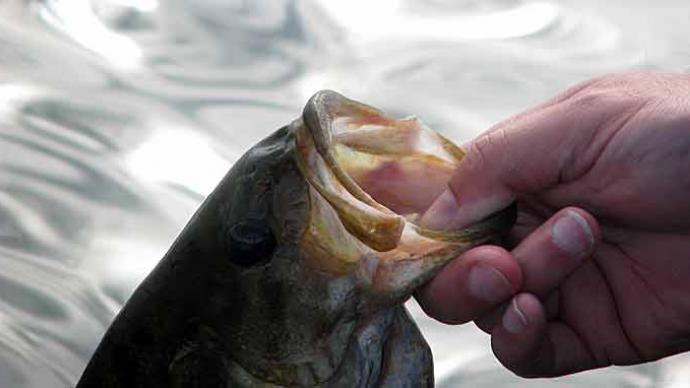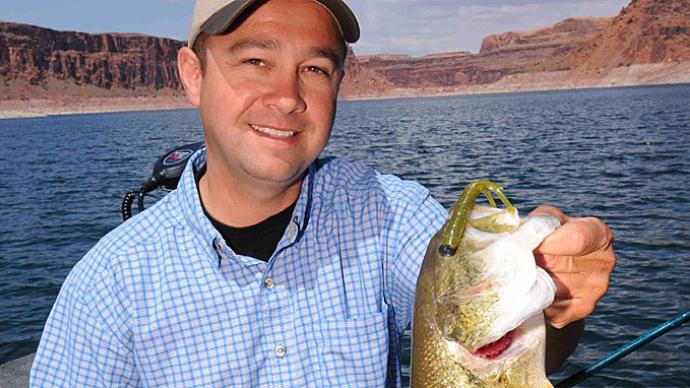
Have you thought about how your fish spawn? It's easy to take this process for granted. After all, you can look off the dock and see baby fish during different times of the year. You know your fish spawned because you can see the results.
Understand how the different species of fish spawn and you'll better understand the mystery of your underwater world. Part of that mystery is realizing the timing of each spawn, where and how, and the different temperatures. Then, the jigsaw puzzle offish life makes even more sense than it does now.
There are some common threads with spawns that you need to know. First, when those baby fish are first hatched, they make a living off what was the yolk of the egg. When the yolk is absorbed, they need nourishment. When you think about it, a baby fish has no energy stores, no body fat and a rapid metabolism to grow as fast as possible. These baby fish, each species, have tiny mouths, and must have tiny food to eat. That means plankton and microscopic algae, periphyton and bio-film. If you have clear water, survival rates of baby fish will be drastically low. And, imagine a tiny fish, not much bigger than a mechanical pencil lead, trying to find its food, when a mean ol' dragonfly larvae eats it in two bites. That's right, insects also prey on your baby fish. So, spawning habitat and a good food chain are key components in successful fisheries.
When you first stocked your pond, odds are you added Fathead minnows. Those slow moving creatures are a key ingredient to new ponds. Don't add them to existing ponds, though. But, when you stocked them, if they had adequate places to spawn, they filled your pond with little offspring. If not, you probably didn't see many. Fathead minnows, as prolific as they are, lay their eggs on the underneath side of firm objects, in shallow water. They love rocks, plastic, wooden pallets and docks, as long as they can scrape off a place with the little bumps on their noses. The males form dark little knots on their nose, called tubercles. Males make a nest by scraping a place about as big as a silver dollar. They'll find a ripe female, she'll turn and eggs will come out, he'll fertilize them, grab them with his nose and push the sticky little dark things onto the nest, where they'll cling until hatching. There may be 400500 eggs per spawn, and when those hatch, he'll use his face and clean off the shells and do it again, over and over, until he literally runs out of gas. Then, since he hasn't eaten, the little martyr gives up the ghost after he's assisted bringing four to six spawns of his offspring into the pond world.
Golden shiner minnows are totally different. They'll typically spawn when water temperatures rise above 68 degrees F. They spawn at daylight, running the edge of a pond, depositing sticky eggs on vegetation. It's not unusual to see them spawning from dawn until just after daylight. Each female deposits between 1020,000 eggs per spawn and the babies will hatch in just three or four days and run in schools, gleaning their food from the water column, as insects eat them. In a perfect world, with excellent opportunity, Golden shiners will spawn from spring, all the way into fall, with several peaks along the season. You need grass for them to lay their eggs along pond's edge. Culturists use mats that look like old-time swamp cooler filters and transfer eggs daily to fertile culture ponds.
Speaking of grass, Threadfin shad spawn similarly, but during a slightly different temperature range. They'll start around 66 degrees and go in cycles, similar to Golden shiners, all summer long. They run the perimeter of a lake, seeking grassy substrates. In ponds where we intend to assist threadfins, we'll add chunks of straw or Bermuda grass hay around the shoreline. That's a great substrate for threadfins to lay their eggs.
What about sunfish? Good question. Bluegills and redear sunfish are colony spawners, making crater-like nests, side by side, in really shallow water. Most sunfish beds are in water less than two feet deep. Bluegills and redear sunfish prefer gravelly substrate, but will choose sandy areas, or even areas with mud, if they can whisk away silty soils and get to something firm. Redear tend to spawn once yearly, but bluegills are multiple spawners. I've seen more than a hundred bluegill nests in one colony. If you have a bass lake, you want multiple areas for bluegills to spawn. How many, you might ask? If there are three areas about as big as the hood of a pickup truck in a one-acre pond, that's enough. For a three-acre pond, if you have 58 prime areas, that's good. The male bluegill swims around and around, using his fins and fast pace to sweep out a crater about as big as a cattle hoof-print. If you see a big area of those craters, you have a colony of sunfish spawning. When the colony is full offish, it's fun to just stand and watch as each male goes about, flitting, swirling, circling in attempts to protect his area from all invaders, even his little boy neighbors. One bit of frustration we'll have here is watching Great Blue Herons picking off those nesting bluegills one at a time, leaving that bed vacant.
What about bass? Largemouth and smallmouth bass make a shallow crater, as big as two feet in diameter. No neighbors. I've seen spawning beds in gravel, on top of tree stumps, and in muddy areas, where a bass can sweep out the loose soils. But I've seen these beds in water deeper than six feet and as shallow as two feet. The male builds the nest, entices a ripe female to his lair and as she comes close, he'll bump her. She'll turn slightly sideways and eggs will pour out. He's sidled up to her, and if you are in the right place at the right time, you'll see him squirt his milt onto the eggs, and deftly use his fins and body to guide the fertilized eggs into the bottom of his fresh, clean nest. Daddy will stay with the eggs until they hatch and become swim-up fry, then he'll nudge the moving school into shallow water and wish them luck. Bass spawn in cycles of the full moon. Smallies spawn once or twice in the spring and early summer. Largemouth bass typically spawn when water temperature rises into the low 60's. The biggest females commonly spawn twice. That's because they have so many eggs that not all of them mature at the same time. So, big girl bass will lay as many eggs as are ready, then in the next cycle of the full moon, they'll spawn again, until spent.
How about your channel catfish? They are last to spawn in the spring cycles. Channel catfish lay their eggs in cavities, when the water temperature is consistently in the low 70's. The male will go inside a cavity, whether it's a hollow log, a washout under the shoreline, or in a container placed there for that purpose. If you want channel catfish to spawn, here's a tip from a longtime catfish farmer, shared with me decades ago. Back then, those guys used cream cans with a small neck, opening into a bigger area, like a bucket. You want the fish to be able to enter, turn around, and then, have a lip where the baby catfish can't roll out when they hatch. The male will entice a female who's ready, and she'll lay her eggs. He'll fertilize them, roll the yellow little nougats into a spongy mass and guard them, sweeping fresh water over them so they can breathe. By the way, all fish eggs need to breathe or they won't hatch. The shells are permeable, and exchange of oxygenated water is critical to their health. Channel catfish eggs take about a week to hatch and another few days to absorb their yolks and become what we call swim-up fry. It's fascinating to watch these babies go from bright yellow, tiny tootsie-roll pop-shaped, squiggly little fry to dark, sleek, little whiskered creatures that look like their parents in a couple of weeks.
So, there you have it, a primer on your primary fish. If you have a basic understanding of how your fish spawn, where they do it, and circumstances they need, you can assist the success and survival of yours. That's part of the fun of pond management, plus it's good information to know to be sure your pond is the best it can be.
Reprinted with permission from Pond Boss Magazine



